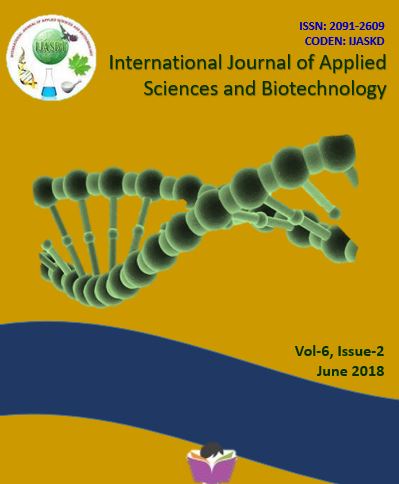Intratesticular Injection of Calcium Chloride Is a Useful Alternative for Neutering the Male Dog
DOI:
https://doi.org/10.3126/ijasbt.v6i2.20431Keywords:
Calcium chloride, intratesticular, neutering, histopathologicalAbstract
Nepal is a rabies endemic country where stray and community dogs are the main reservoir of this life threatening diseases. The orchidectomy is performed to control the male dog population, which is supposed to be very painful and invasive thereby not rational in context of animal welfare. Therefore present study was undertaken to study the efficacy of single intratesticular injection of calcium chloride for neutering of the male dog. Twelve apparently healthy male dogs were randomly allocated into 3 groups (n=4). Group-I received single bilateral intratesticular injection of 20% calcium chloride together with 1% lignocaine-HCl at dose determined accordingly with testicular width. Similarly, Group-II received a single bilateral intratesticular injection of sterile normal saline containing 1% lignocaine-HCl. However, the orchidectomy was performed following the standard surgical protocol in the dogs of Group-III. Histopathologically, the calcium chloride injected testicular section demonstrated dissolution of the germ cell association, atrophied seminiferous tubules and washing out of the germ cells from the tubules. In some area, there was coagulative necrosis of the seminiferous epithelium and interstitial spaces as well as degenerated and coagulated germ cells in combination with fibrous tissue. Intertubular edema, fibrosis, hemorrhage were also evident. Some necrotic cells showed desquamation or even calcification. Intertubular vessels were severely congested. There was complete loss of tubular architecture without any distinct boundary between the tubular and extra tubular compartment in some region of testis. The intratesticular injection of 20% calcium chloride did not show any apparent pain, stress, metabolic toxicity and untoward side effect. Histomorphological findings revealed the uneven distribution of damage and inconsistent affect on seminiferous tubules. Therefore, intratesticular injection of calcium chloride could be useful alternative for neutering the male dog.
Int. J. Appl. Sci. Biotechnol. Vol 6(2): 158-163




